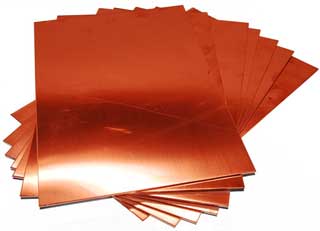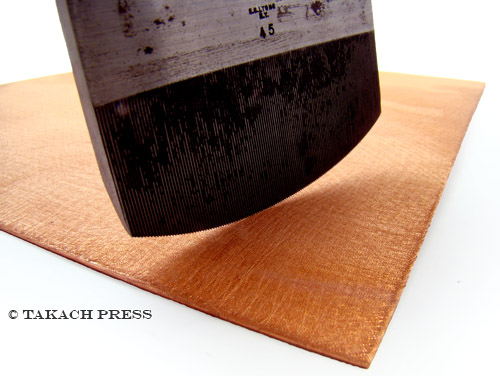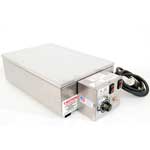Copper Plate
Industrial grade copper 18 Gauge (.050"). Not polished or back-stopped but offers a savings. Recommended for use with Z*Acryl etching tank, ferric chloride, traditional acid bath etching, aquatint, engraving and mezzotint.
Quality
 Our copper plates are protected by a PVC coating, applied to one side to prevent damage to the working side of the plate. The printmaker must inspect the copper plate for scratches and anomalies and remove them from the surface of the copper plate prior to beginning any printmaking process. The PVC coated copper plate reduces damage to the surface of the copper plate during shipment and handling. This protective PVC coating is removed by the printmaker prior to use.
Our copper plates are protected by a PVC coating, applied to one side to prevent damage to the working side of the plate. The printmaker must inspect the copper plate for scratches and anomalies and remove them from the surface of the copper plate prior to beginning any printmaking process. The PVC coated copper plate reduces damage to the surface of the copper plate during shipment and handling. This protective PVC coating is removed by the printmaker prior to use.
Sizes
- 3200405 04" x 05"
- 3200609 06" x 09"
- 3200810 08" x 10"
- 3200912 09" x 12"
- 3201218 12" x 18"
- 3201824 18" x 24"
- 3202436 24" x 36"
- 3203648 36" x 48"
Price
Copper plate as with all metals, copper prices fluctuate for the most current price see copper plate on our online store. We sell copper plate in several sizes and offer quantity discounts.
Quantity Pricing
- 1-10 plates base price
- 10-50 plates economy pricing
- 50+ Plates wholesale price
Mezzotint
 A mezzotint is a intaglio matrix that is worked with a mezzotint rocker to have a consistent tooth, that will hold ink. Copper plate is the ideal matrix for making mezzotints, it is not so hard that the mezzotint rocker will be damaged, yet it offers excellent retention of detail considering the pressures required during printing. If printed without modifying the tooth generated by the rocking of the plate, a mezzotint plate would print with a rich intense field of color. To add the range of tonal values necessary for an image to be present, the mezzotint plate is then worked by the printmaker with a scraper and a burnisher, in a reductive method, to remove the ink holding tooth. By softening areas of the mezzotint tooth the printmaker can create a range of values, completely removing the tooth will result in white space. This method of creating the imagery from a dark field is termed maniere noire, or the black method. This process is extremely time consuming, therefore Takach Press offers Hand Rocked Copper Mezzotint Plate, for your convenience.
A mezzotint is a intaglio matrix that is worked with a mezzotint rocker to have a consistent tooth, that will hold ink. Copper plate is the ideal matrix for making mezzotints, it is not so hard that the mezzotint rocker will be damaged, yet it offers excellent retention of detail considering the pressures required during printing. If printed without modifying the tooth generated by the rocking of the plate, a mezzotint plate would print with a rich intense field of color. To add the range of tonal values necessary for an image to be present, the mezzotint plate is then worked by the printmaker with a scraper and a burnisher, in a reductive method, to remove the ink holding tooth. By softening areas of the mezzotint tooth the printmaker can create a range of values, completely removing the tooth will result in white space. This method of creating the imagery from a dark field is termed maniere noire, or the black method. This process is extremely time consuming, therefore Takach Press offers Hand Rocked Copper Mezzotint Plate, for your convenience.Degreasing
 Whiting Powder is used to degrease copper plate before applying acid resists. It is essential to have a very clean surface on copper plates that are going to be etched. The resists used when etching copper plates must have a clean plate surface to adhere to. Any oils present on the plate will reduce the adhesion of acid resists and cause uneven etching.
Whiting Powder is used to degrease copper plate before applying acid resists. It is essential to have a very clean surface on copper plates that are going to be etched. The resists used when etching copper plates must have a clean plate surface to adhere to. Any oils present on the plate will reduce the adhesion of acid resists and cause uneven etching.
Procedure
- Copper Plate - Remove the protective film from the copper plate.
- Deburr and Bevel -Use a Deburring tool, scraper, or file to create beveled edges on the copper plate.
- Whiting - Make a paste of whiting powder and water and rub the surface of the plate.
- Vinegar - Apply household vinegar and massage over the plate surface.
- Water - Rinse the plate notice how the water sits on the surface of the plate.
- Repeat these steps until water does not bead up on the surface of the plate.
Aquatint
 Powdered Rosin is used as the acid resist when producing aquatints.An aquatint creates a tooth on copper plate that holds ink. Through variations and manipulations this tooth can be made to be rich and smooth like velvet, or it can exhibit the complete tonal range. Aqua tints are created by applying powdered rosin (particles of pine tree sap) evenly at approximately 50% coverage onto the surface of a degreased copper plate.
Powdered Rosin is used as the acid resist when producing aquatints.An aquatint creates a tooth on copper plate that holds ink. Through variations and manipulations this tooth can be made to be rich and smooth like velvet, or it can exhibit the complete tonal range. Aqua tints are created by applying powdered rosin (particles of pine tree sap) evenly at approximately 50% coverage onto the surface of a degreased copper plate.
Fusing
 The rosin particles must then be fused to the plate surface with sufficient heat, employing a flame, heat gun, or hot plate are common studio practices. Used to fuse powdered rosin for copper plate aquatints. Before etching an aqua tint, the back of the copper plate must be protected from the acid, this process is called back stopping the plate. Using hard ground paint the back of the copper plate to achieve 100% coverage. Etching the plate can be accomplished in traditional etching bath, or with the less toxic vertical etching tank and ferric chloride. Test the strength of acid bath be etching an aquatint plate in incremental steps, stopping out each increment with stopout varnish. This copper plate should then be inked, wiped, and printed. Hang it near the acid bath as a visual tool to help determine acid strength and desired etch times.
The rosin particles must then be fused to the plate surface with sufficient heat, employing a flame, heat gun, or hot plate are common studio practices. Used to fuse powdered rosin for copper plate aquatints. Before etching an aqua tint, the back of the copper plate must be protected from the acid, this process is called back stopping the plate. Using hard ground paint the back of the copper plate to achieve 100% coverage. Etching the plate can be accomplished in traditional etching bath, or with the less toxic vertical etching tank and ferric chloride. Test the strength of acid bath be etching an aquatint plate in incremental steps, stopping out each increment with stopout varnish. This copper plate should then be inked, wiped, and printed. Hang it near the acid bath as a visual tool to help determine acid strength and desired etch times.
Etching
Traditionally called a mordant the etchant is an acidic solution used to bite a copper plate. Biting is a term used to describe the removal of copper from areas unprotected by resists. The strength of the acid used to etch copper plate effects how fast it "bites" into the plate. Acid resists are used to create variation in the etching ability and timing of the surface of the copper plate. By controlling this variation of the bite, the printmaker has control offer the image creation.
Tank
 Vertical Etching Tank
Vertical Etching Tank
Ideal bath to etch copper plate with ferric chloride. Vertical design allows bubbles to rise off plate surface and requires less studio space.
Etchant
 Ferric Chloride
Ferric Chloride
Etching solution commonly used in vertical bath to etch copper plates.
Engraving
Similar to etching, engraving removes material from the surface of the copper plate though this process is mechanical, not relying on the chemical reaction of acid and copper. By applying force to a sharp tool the printmaker removes material from the surface of the copper plate, the resulting incised lines will hold ink. The line created by engraving is very distinctive, having a tapered width and depth on the leading and trailing ends of the line. Angle tint tools, Burins and Halftone rakes ar examples of common engraving tools.Drypoint
Unlike engraving and etching dry point methods of plate manipulation do not remove material from the plates surface, rather the create ink holding areas by deforming the material. Common tools ate the drypoint needle, roulettes and mezzotint rockers.Steel Facing
Steel facing applies a thin layer of electroplated steel, forming a protective layer, on copper plates resulting in many benefits to the printmaker during printing.- Steel facing copper plate increases the life of the plate.
- Little to no loss of detail is reported.
- Discoloration of light colored inks is minimized.
 Deburring Tool
Deburring Tool